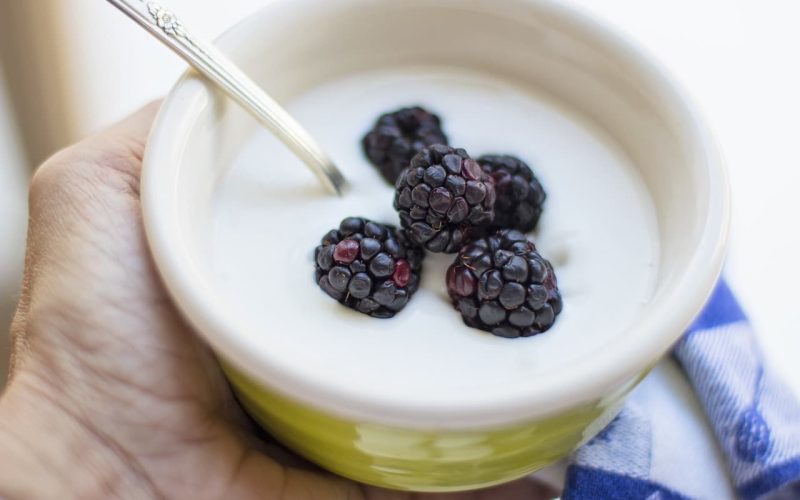Did you know that there are different types of yogurts? Yogurt is now available in such wide varieties on grocery store shelves.
Because of its great flavors and health benefits, it is a common delicacy worldwide. Yogurt comes in both dairy and non-dairy variants and can be plain or flavored.
Depending on the various fermentation techniques used, it has a variety of textures and consistencies.
Yogurt is a well-liked food due to its health advantages and being an essential component of a tasty parfait and the foundation of many delicious homemade sauces and dips.
Calcium (1), vitamin B12, and other important minerals like phosphorus and riboflavin are all reasonably present. If you choose Greek, you will also get more protein.
Depending on the different types of yogurts, the process can vary, but yogurt is generally milk that has undergone lactic acid fermentation, a type of fermentation.
To begin fermentation, milk is mixed with healthy bacterial strains known as live cultures (specifically, S. thermophilus and L. bulgaricus).
The bacteria convert the milk’s lactose sugars into lactic acid. The milk’s proteins coagulate as a result of the environment’s acidity.
This gives it a more gel-like and creamy texture in addition to the beneficial probiotics that medical professionals have long praised.
Furthermore, it’s critical to be aware that some producers overheat the yogurt after adding the cultures, which might destroy the beneficial bacteria.
Below are the different types of yogurts we have.
1. Traditional yogurt
Traditional yogurt is one of the different types of yogurts that most people are familiar with. You probably saw regular yogurt if you’ve ever seen it with a thin layer of liquid on top.
While plain yogurt (or any variety) is available, this meal has a naturally sour taste. Yogurt is now available in low-fat, non-fat, and standard varieties.
The milk used in the fermenting process differentiates these two choices. Be careful that non-fat yogurt typically has more sugar added to compensate for its lack of flavor.
2. Greek yogurt
Greek Yogurt has become ubiquitous in recent years, and you can only open a refrigerator at the supermarket if you find some.
But Greek yogurt has some extra advantages over regular yogurt, including more protein, fewer carbohydrates, and less sugar.
Therefore, Greek Yogurt is a better choice if you’re genuinely trying to eat healthily and need a yogurt fix.
However, some companies add many sugar and additives, so read the label carefully beforehand.
Greek yogurt is significantly thicker than regular yogurt since it has been strained, setting it apart from other formulations.
All of the whey from normal yogurt is removed to create Greek Yogurt. It becomes extraordinarily rich, creamy, and pleasant due to this process.
It’s a great choice for healthy eaters because it contains protein, probiotics, and heart-protective elements.
What makes Greek yogurt so good? It’s so adaptable! But no matter your path, Greek Yogurt will always improve your day.
3. Goat Milk Yogurt
Next on our list of different types of yogurts is Goat Milk Yogurt. Goat milk is a terrific alternative if you don’t feel as hot after drinking a cup of the other stuff because, according to a recent study, 93% of infants who are allergic to cow’s milk may consume it without experiencing any adverse effects.
Additionally, it has a taste that some people may not like, comparable to goat cheese, but with a smoother, richer, and creamier texture than cow milk yogurt.
Goat milk yogurt often has higher fat levels. However, skimming the cream layer on top can reduce the fat content.
While using only natural ingredients and no refined sweeteners, this goat yogurt has a sweet and tangy flavor. At the bottom, there is fruit as well, so you can acquire an extra bite.
4. Australian yogurt
If Greek Yogurt is too thick for you, but regular yogurt is too thin and liquid, consider Australian yogurt instead. This type has a much creamier consistency because it is made using full milk.
Additionally, this product is unstrained so that the top will contain some extra liquid. Australian yogurt is frequently sweetened with honey.
Since the honey also contributes to the velvety texture, simple versions will need a little more stirring. Highlights include a creamy texture and a sweet flavor character.
5. Plain Yogurt
Plain yogurt is one of the different types of yogurts we have. Yogurt, in its most basic form, is delightful.
It makes the ideal empty canvas for any topping you can imagine. You can eat it simply with a spoon or with fruit and granola.
It is the ideal foundation for practically everything because of its light, creamy texture and tangy flavor. The ways to eat plain yogurt are countless.
The term “kitchen staple” is entirely appropriate for this delight! One cup has 8.5g of protein, 11g of carbohydrates, 8g of fat, and 11g of sugar.
6. Sheep Milk Yogurt
Sheep yogurt is from sheep’s milk. It has a natural, earthy flavor. It is creamier and thicker than conventional cow’s milk, similar to Greek Yogurt. But because it has less lactose than dairy yogurt, it is a fantastic substitute.
If you want a yogurt that tastes and feels like cow’s milk yogurt but doesn’t typically tolerate it well, try sheep’s milk yogurt. This is a great source of calcium, riboflavin, and B vitamins.
Because it doesn’t degrade at high temperatures like other yogurts, this yogurt is perfect for cooking.
However, sheep milk has a higher fat content than cow milk. We advise plain so you may use it for cooking!
7. Icelandic yogurt
Yogurt is generally fairly smooth and simple to stir. However, because Icelandic Yogurt is strained four times, it is significantly thicker(compared to three for Greek varieties). It is one of the different types of yogurts.
Skyr is frequently referred to as cheese in Iceland. Skyr contains four cups of non-fat milk each, which implies that it contains much more protein than regular yogurt.
In rare instances, a serving may include up to 20 grams. Although skim milk is the ideal basis, more recent iterations will use fattier milk, like one or two percent.
Iceland, where Skyr was a specific aspect of medieval life, is famed for its history. Locals claim that Skyr has existed since the ninth century, making it one of the oldest products you will discover on the market.
8. Kefir Yogurt
Turkish yogurt called kefir is made from kefir grains. It is lovely yogurt you can sip because it is light and liquid.
This yogurt beverage will make you feel great because it contains vitamins, proteins, and probiotics.
The fact that Kefir yogurt frequently contains probiotic bacteria strains is another reason to consume it.
Kefir is also incredibly high in fat, so if you’re trying to reduce your intake, be sure to take note. It tastes tangy and creamy and fizzes a little. Nutritional information per cup: 9g carbohydrates, 8g fat, 8g protein, and 7g sugar.
9. Soy Yogurt
Next on our list of different types of yogurts is Soy yogurt. Soy yogurt begins with a foundation of soy milk manufactured from soybeans thickened by adding living cultures.
It is a go-to for yogurt lovers avoiding animal protein because it is dairy-free, low in cholesterol, and dairy-free.
The most challenging aspect of this delicacy is how difficult it is to locate an unsweetened version without additional thickeners. There aren’t any strong flavors, and the consistency is similar to a liquid.
The plus: Soy yogurt may block certain enzymes that affect the digestion of carbohydrates, slowing blood sugar rise after meals.
Put half of the six-ounce jar in a smoothie with spinach and a banana instead of eating the entire thing. You’ll consume less sugar while still enjoying some fantastic flavors!
10. Almond Milk Yogurt
Almond milk has a naturally low-calorie content and is made from ground almonds and water. To make almond yogurt, live, active microorganisms are added.
Almond Yogurt is a non-dairy yogurt that is high in calcium and fiber and low in fat and sodium.
If you want to stay away from lactose and dairy, try this tasty alternative. Its thin, loose texture is comparable to that of regular yogurt.
It is challenging to find a brand that doesn’t contain thickeners and sweeteners, even in their simple taste choice, unless you’re creating this yourself.
Since many of those components are removed when making milk, the protein counts are often lower in yogurt made with almonds.
11. Probiotic Yogurt
This is one of the different types of yogurts we have. Yogurt with probiotics is a tasty and healthy treat you can have whenever you want.
It is a combination of cultures that benefits your immune and digestive systems. It facilitates digestion and nutrition absorption. Probiotics are like your body’s small helpers.
Probiotic yogurt is a great way to get your daily dose of probiotics. It’s also an excellent source of calcium, protein, and vitamins.
It’s important to note that not all yogurts contain probiotics, so make sure you check the label before buying.
Additionally, some brands may contain added sugar or artificial sweeteners, so read the ingredients list carefully. This one, you’ll thank the bacteria for!
12. Coconut Yogurt
Whether or not you like coconut, your taste buds may or may not enjoy this. However, if you do, you’re more likely to enjoy this!
Coconut yogurt is made by combining live cultures with coconut milk extracted from the white meat of the coconut, which is rich in good fats. Normally, coconut milk has a thicker viscosity that is comparable to whole milk or heavy cream.
However, when it is converted into yogurt, the consistency is thin and comparable to regular yogurt.
Even though coconut milk is delicious and enticing, coconut yogurt typically lacks protein and is hard to find in stores with an ingredient list free of added sugars. Without sugar, this yogurt also tends to be sour and unappealing to many.
13. Dahi Yogurt
As we continue our “cultural” tour of the world, we come to Southeast Asia and encounter Dahi.
India, Bangladesh, and Nepal are the nations that consume it the most. Dahi is one of the different types of yogurts.
However, other nations in the region occasionally indulge. Most frequently, dahi is used as a basis for other meals to help balance their spice. It can be included in a local yogurt beverage known as Lassi.
14. Lassi
Yogurt is used to make the traditional Indian beverage known as Lassi. A blend of water, yogurt, and spices is used to make it; occasionally, fruits are included.
Like a smoothie, Lassi has a thick and creamy texture. Although generally made with sweet toppings, this yogurt-based beverage also functions as a salty beverage.
Rich spices and tart yogurt combine to provide an incredible flavor symphony. This yogurt beverage is delicious and full of probiotics and minerals.
15. Matsoni Yogurt
Matsoni is the best choice if you’re searching for a quick and simple method to manufacture yogurt at home. This kind is also a product of the Middle East, where nations like Iran are most prevalent.
In contrast to most yogurts, the bacteria don’t need a consistently hot environment to function. Combine some milk (of any type you like) with a starter culture, and allow it to settle for a few hours.
The outcome is a tart and creamy meal that you can substitute for other yogurt options or as a starting point for different cuisines.
It is among the different types of yogurts we have. You can buy pre-made Matsoni if you don’t want to let milk ferment on your counter.
16. Swiss yogurt
Another unusual yogurt with excellent flavors is Swiss Yogurt. When the cultured milk was incubated and cooled in a sizable tank, Swiss Yogurt was created.
The mixture is continued until it has a thick, creamy texture. It is one of the different types of yogurts.
Some store-bought Swiss yogurts have fruit purees and added sugars to enhance the flavor.
Nutritional Information per 170-gram container: 9 g protein, 27 g carbs, 3 g fat, and 25 g sugar.
17. Doogh
Last on our list of different types of yogurts is Doogh. Are you looking for a novel and mouthwatering yogurt recipe? Doogh is the way to go, then!
Doogh’s classic Persian beverage combines yogurt, sparkling water, and salt. The result is a nutritious and probiotic-rich bubbly beverage. Although it may sound unusual, it is utterly delicious!
Conclusion
Different types of yogurts can be stored in the refrigerator. You do want to enjoy it cold, after all.
Yogurt can last up to three weeks in the refrigerator and occasionally longer because it goes through the fermentation process.
The shelf life that the makers recommend will be affected by the many strains of living cultures utilized in its production. It relies on the balance of lactose and lactic acid in the end.
Always check the expiration date on your carton, but if you don’t open it, it might last an extra week or two.
The different types of yogurts are mentioned above. Yogurt is an excellent foundation for marinades, sauces, and dips (the acid content makes it a great meat tenderizer).
Different yogurts are available, from traditional Greek Yogurt to Lassi and Swiss Yogurt.
Each type of yogurt offers a unique flavor, texture, and health benefits. No matter the type of yogurt you choose, it’s important to store it properly in the refrigerator to ensure maximum freshness and flavor.








